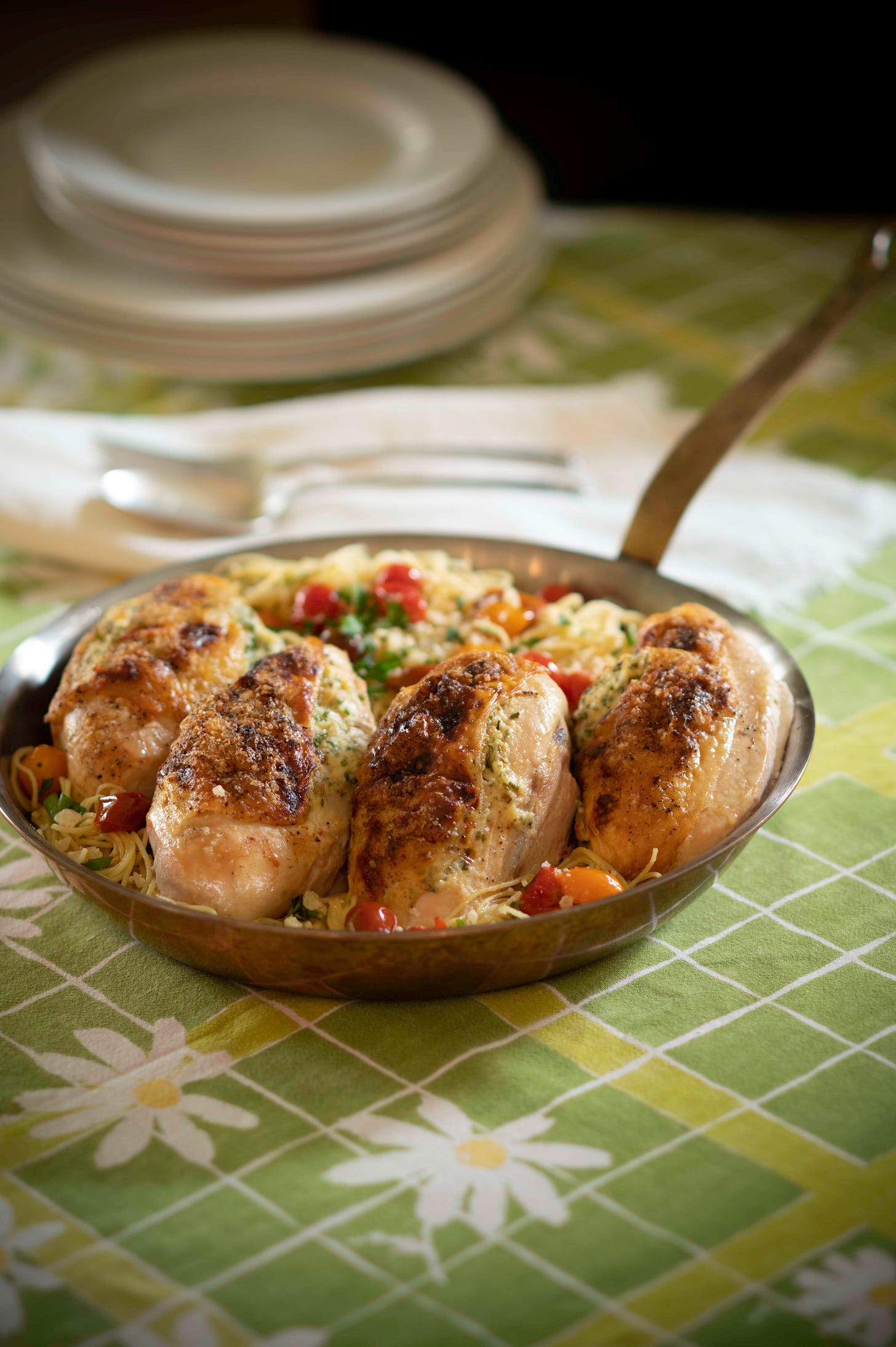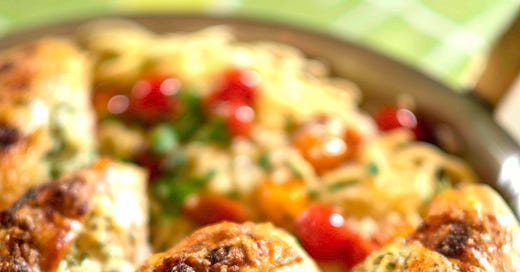Everyone who loves French food needs to know about Richard Olney. This simple recipe is a great introduction to his work.
My take on an Iconic Recipe from one of America's most influential French-food cookbook authors. (No, not Julia, not James, not MFK. Richard.)

I have a soft spot in my heart for Richard Olney—not just because he’s an amazing French-food cookbook author, but because he hails from rural Iowa (in my home state). True, he skedaddled on over to France at the age of 24, in 1951, and lived there until he died in 1999. But Iowans can claim him—his work ethic and ability to build things with his hands were due, in part, to being born and raised in small-town Marathon, Iowa.
“You could take Richard out of Marathon, but you could never take Marathon out of Richard.”—Byron Olney (Richard’s brother), quoted in The Gourmand’s Way, by Justin Spring.
He restored a farmhouse in Provence long before it was cool to do so. In 1961, to be exact. And he did this himself—with his own hands! Over the years, he installed plumbing, built furniture, and constructed a terrace, and more. (I’d love to see MFK, James, or Julia do all that!)
Also impressive: He not only wrote great tomes for the American cook, but he actually wrote a column on French food, in French, for the French magazine, Cuisine et Vins de France. You know he had to be good—superior, in fact—to pull that off as an American!

Fortuitously, I was deep in my Richard Olney fascination when I was asked to revise my own French cookbook. In his book, “Simple French Cooking,” I found the perfect solution to a recipe problem I was having.
I liked my chicken breasts stuffed with goat cheese and fines herbes … but I always felt it could be better. In his book, Olney has a somewhat similar recipe for stuffing chicken—but he uses ricotta. Genius! That creamy-soft cheese is a great choice for stuffing chicken breasts because it’s rich and consistent, and doesn’t ooze out of the chicken all over the place. In cooking, semi-ripened goat cheese can be all over the map in terms of texture, meltability, and flavor (and forget fresh goat cheese—boring!). And while ricotta is not French, you can stir in a bunch of favorite French herbs, and it’s French enough in my book, literally!
So, if you don’t know of Richard Olney, give this recipe a try for a great introduction.
First: A few things you should know about the chicken: Skin is essential—you tuck the stuffing under the skin and it adds so much flavor to the dish. Bone-in, skin-on chicken breasts are going to be easiest to find; however, you can often find boneless skin-on breasts, or even airline chicken breasts (which have the skin on, but are boneless except for the wing-bone).
My absolute favorite cut for this, however, is boneless skin-on thigh portions. I’m lucky to be able to source these from a farmer here in Iowa; you might have to search around or ask at an artisanal butcher.
At any rate, whether you use skin-on boneless thighs or boneless chicken breasts, the dish will be more elegant and easier to eat than using bone-in breasts. But if the latter are all you can get, go with it. It will still be a lovely dish.
Roast Chicken Breasts Stuffed with Ricotta, Shallots, and Fines Herbes
From my book, Everyday French Cooking: Modern French Cuisine Made Simple.
Serve this with a nice lemon-sparked salad in summer—put the chicken and the salad on the same plate so that the lemony salad dressing acts as a sauce for the entire dish. In winter, a good accompaniment is Angel Hair Pasta with Fresh Grape Tomato Sauce (page 165 in my book), as shown here.
3 tablespoons extra-virgin olive oil
1 large shallot, minced (about 1⁄4 cup)
2 garlic cloves, minced
2 tablespoons snipped fresh parsley
1 tablespoon snipped fresh chives
1 tablespoon snipped fresh tarragon
1⁄2 cup whole-milk ricotta cheese
Salt and freshly ground black pepper to taste
4 bone-in, skin-on chicken breast halves (6 to 8 ounces each)*
1. Preheat the oven to 425°F.
2. Heat 1 tablespoon of the olive oil in a medium-size skillet over medium heat until it shimmers. Add the shallot and cook, stirring, until tender but not brown, 4 to 5 minutes. Add the garlic, parsley, chives, and tarragon; cook, stirring, until the garlic is fragrant, about 30 seconds more. Transfer to a bowl; cool slightly.
3. Stir the ricotta cheese into the shallot mixture; season with salt and pepper. Slide your fingers under the skin of each chicken breast half to separate it from the meat while leaving it attached on one side. Spoon one-fourth of the filling onto the meat under the skin of each breast. Pull the skin back over the breast to cover the filling. Season the breasts with salt and pepper and brush with the remaining 2 tablespoons olive oil. Place the breasts, skin side up, in a baking pan large enough to hold them in one layer.
4. Bake until the internal temperature of the chicken registers 165°F on an instant-read thermometer, 35 to 40 minutes.** Allow the chicken breasts to stand for 5 minutes before serving.
*Use skin-on, boneless breasts or thigh portions if you can find them. If using thighs, check out the size—you might have to use two per person (stuffing amount should be the same, as they’re smaller).
** If using boneless breasts or thighs, start checking after 25 minutes.
A Little Help?
This recipe is part of my growing list of 25 essential French recipes. Each of my recipes offer an all-new find or a unique take that you won’t already find elsewhere on the Internet. If you’d like to support this archive, please consider a subscription.





Should read "some other circles, as well"
The shallots and tarragon would be singing in harmony here. Olney is also written about in some circles as well. Kermit Lynch's Adventures on the Wine Route is a nice examaple, Richard Olney prefaces the original 1988 Edition. Kermit Lynch was among those who gathered in France with Olney, like Alice Waters, for inspiration and guidance....Olneys own words in his books are also a nice read as well. He had a wonderful grasp of French wine...for an kid from Marathon, Iowa, orginally.